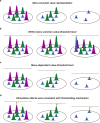Transforming absolute value to categorical choice in primate superior colliculus during value-based decision making
- PMID: 34099726
- PMCID: PMC8184840
- DOI: 10.1038/s41467-021-23747-z
Transforming absolute value to categorical choice in primate superior colliculus during value-based decision making
Abstract
Value-based decision making involves choosing from multiple options with different values. Despite extensive studies on value representation in various brain regions, the neural mechanism for how multiple value options are converted to motor actions remains unclear. To study this, we developed a multi-value foraging task with varying menu of items in non-human primates using eye movements that dissociates value and choice, and conducted electrophysiological recording in the midbrain superior colliculus (SC). SC neurons encoded "absolute" value, independent of available options, during late fixation. In addition, SC neurons also represent value threshold, modulated by available options, different from conventional motor threshold. Electrical stimulation of SC neurons biased choices in a manner predicted by the difference between the value representation and the value threshold. These results reveal a neural mechanism directly transforming absolute values to categorical choices within SC, supporting highly efficient value-based decision making critical for real-world economic behaviors.
Conflict of interest statement
The authors declare no competing interests.
Figures








Similar articles
-
Comparison of saccades perturbed by stimulation of the rostral superior colliculus, the caudal superior colliculus, and the omnipause neuron region.J Neurophysiol. 1999 Dec;82(6):3236-53. doi: 10.1152/jn.1999.82.6.3236. J Neurophysiol. 1999. PMID: 10601457
-
Controlled movement processing: superior colliculus activity associated with countermanded saccades.J Neurosci. 2003 Jul 23;23(16):6480-9. doi: 10.1523/JNEUROSCI.23-16-06480.2003. J Neurosci. 2003. PMID: 12878689 Free PMC article.
-
Linking express saccade occurance to stimulus properties and sensorimotor integration in the superior colliculus.J Neurophysiol. 2015 Aug;114(2):879-92. doi: 10.1152/jn.00047.2015. Epub 2015 Jun 10. J Neurophysiol. 2015. PMID: 26063770 Free PMC article.
-
Neurons in the primate superior colliculus coding for arm movements in gaze-related coordinates.J Neurophysiol. 2000 Mar;83(3):1283-99. doi: 10.1152/jn.2000.83.3.1283. J Neurophysiol. 2000. PMID: 10712456
-
Translation of sensory signals into commands for control of saccadic eye movements: role of primate superior colliculus.Physiol Rev. 1986 Jan;66(1):118-71. doi: 10.1152/physrev.1986.66.1.118. Physiol Rev. 1986. PMID: 3511480 Review.
Cited by
-
Involvement of superior colliculus in complex figure detection of mice.Elife. 2024 Jan 25;13:e83708. doi: 10.7554/eLife.83708. Elife. 2024. PMID: 38270590 Free PMC article.
-
Collicular circuits supporting the perceptual, motor and cognitive demands of ethological environments.Curr Opin Neurobiol. 2023 Oct;82:102773. doi: 10.1016/j.conb.2023.102773. Epub 2023 Aug 22. Curr Opin Neurobiol. 2023. PMID: 37619424 Free PMC article. Review.
-
Flexible control of representational dynamics in a disinhibition-based model of decision-making.Elife. 2023 Jun 1;12:e82426. doi: 10.7554/eLife.82426. Elife. 2023. PMID: 37261426 Free PMC article.
-
Inhibitory tagging in the superior colliculus during visual search.J Neurophysiol. 2023 Oct 1;130(4):824-837. doi: 10.1152/jn.00095.2023. Epub 2023 Sep 6. J Neurophysiol. 2023. PMID: 37671440 Free PMC article.
-
Effort drives saccade selection.Elife. 2025 Apr 7;13:RP97760. doi: 10.7554/eLife.97760. Elife. 2025. PMID: 40193176 Free PMC article.
References
-
- Morgenstern, O. & Von Neumann, J. Theory of Games and Economic Behavior (Princeton University Press, 1953).
-
- Kahneman, D. & Tversky, A. in Handbook of the Fundamentals of Financial Decision Making: Part I 99–127 (World Scientific, 2013).
-
- Kreps, D. M. A Course in Microeconomic Theory (Princeton University Press, 1990).
Publication types
MeSH terms
LinkOut - more resources
Full Text Sources

